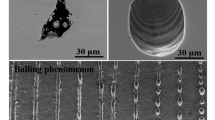Abstract
SIR GEORGE BEILBY1 attributed the polish on metals to the covering over of the surface by a layer of amorphous metal resulting from rubbing, which causes the metal to flow and then harden as a supercooled liquid. Prof. G. P. Thomson's high-speed electron beam camera2 was used to investigate this.
This is a preview of subscription content, access via your institution
Access options
Subscribe to this journal
Receive 51 print issues and online access
$199.00 per year
only $3.90 per issue
Buy this article
- Purchase on Springer Link
- Instant access to full article PDF
Prices may be subject to local taxes which are calculated during checkout
Similar content being viewed by others
References
Sir G. T. Beilby, "Aggregation and Flow of Solids".
G. P. Thomson, Proc. Roy. Soc., A, 128; 1931.
Author information
Authors and Affiliations
Rights and permissions
About this article
Cite this article
FRENCH, R. Polish on Metals. Nature 129, 169–170 (1932). https://doi.org/10.1038/129169b0
Issue Date:
DOI: https://doi.org/10.1038/129169b0
This article is cited by
-
Elektroneninterferenzen an geschmirgelten und polierten Fl�chen
Die Naturwissenschaften (1933)
Comments
By submitting a comment you agree to abide by our Terms and Community Guidelines. If you find something abusive or that does not comply with our terms or guidelines please flag it as inappropriate.



